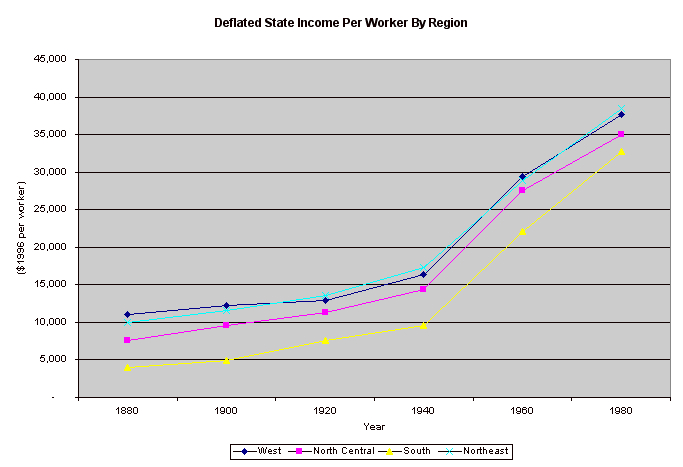U.S. Is a Case Study in Free Trade
American incomes converge, but not at the bottom.
The New York Times, "Economic Scene" , February 25, 2004
We've all heard the dire predictions of what would happen. All the businesses and jobs would rush to the places with the lowest wages. The poor countries would get richer, but only by making rich countries poorer.
Eventually we'd all be roughly equal, but formerly well-to-do Americans would be a lot worse off. Many Americans are afraid that globalization and free trade will have exactly this effect.
We rarely realize that we already live in a version of that theoretical world. The United States is one giant free trade zone. Businesses can move their plants, investors can move their money and workers can move themselves from region to region without government permission.
Over the last century, a lot of that movement has occurred. Rich and poor regions have converged to about the same standard of living. But the results haven't been anything like the "race to the bottom" of protectionist imaginations.
Incomes still vary widely across regions. Income per capita in Connecticut, the richest state, was about $42,000 in 2002, compared with $24,000 in New Mexico, the poorest. (These figures aren't adjusted for price variations between regions.) [Correction: New Mexico actually ranked 47th.--vp]

Suppose we lived in an economic world with no borders, where goods, capital and people could move anywhere.
Today's differences are small, however, compared with the huge differences that used to exist. A century ago, the poor states were like third world countries compared with the richest states. They've caught up only since 1960.
Adjusted for regional price differences, income per worker in the South was just two-thirds of the country's average as recently as 1940, according to calculations by two economists, Kris James Mitchener and Ian W. McLean, reported in The Journal of Economic History.
The disparity was even greater in the late 19th century.
Over the last half-century, "once-poorer states have been growing faster than richer ones," says Professor Mitchener of Santa Clara University in California. "That's going to cause the poor ones to catch up to the richer ones." But, he adds, that doesn't mean impoverishing the rich ones.
In fact, states like New York, California, New Jersey, Connecticut and Massachusetts have remained at the top of the list for more than a century. They've kept growing, though at a slower rate than poorer states. The most dramatic improvement has been in Florida, which was among the poorest states in 1880 and among the richest a century later.
There are two ways a region can raise its income per capita. One is simply to have more people doing paid labor. The other is to increase productivity -- output per worker or per hour worked.
In the late 19th and early 20th centuries, Western mining states like Nevada had the highest per capita incomes, because most of the population was working.
"Mining attracted young males," Professor Mitchener explains. "Those young males didn't bring many wives with them at first, and they didn't have many children, and they worked till they died."
That demographic lift can't last forever, but it can help economic growth start. In East Asia, he notes, there was a huge influx of people into the paid labor force in the second half of the 20th century. The increase in labor force participation helped propel economic growth. Over time, productivity per worker also improved.
In the United States, the Western states became more like the rest of the country after 1940. For those on the Pacific coast, notably California, the lift from mining carried on into continued economic development. Those states remained among the richest in the country. Once mining petered out, less accessible states like Montana fell behind the national average.
Over the long term, increasing productivity is more important and sustainable than just getting more people to work. And that is where the real changes have occurred among this nation's regions.
"In 1880 the United States was poised to overtake Britain as the most efficient industrial economy and become the century-long benchmark against which all other economies' productivity performance would be compared. Yet in that year, labor productivity in the least productive state (North Carolina) was a mere 18 percent of the most productive (Nevada)," wrote Professor Mitchener and Professor McLean of the University of Adelaide in Australia in a more recent study in The Journal of Economic Growth.
That extraordinary difference cannot be attributed to Nevada's mining efficiency alone. North Carolina's productivity was only about 24 percent of California's or New York's. These gaps are comparable to the difference between the United States and Thailand or Morocco today.
Today, North Carolina is still poorer than California or New York, but the difference is much smaller. The free movement of goods, investment capital and labor has in fact helped to equalize regions within the United States -- and, at the same time, to make the whole economy more prosperous by spurring productivity.
Very low productivity means there's more room for investments to pay off by significantly increasing output. In the second half of the 20th century, the South did attract investment from the richer parts of the country. Workers got better training and equipment, and the Southern states began to catch up. Incomes went up faster in the poor regions, but they continued to rise in the rest of the country.
But even in a free trade region like the United States, different legal institutions matter. Most of the South's improvement occurred after 1960, around the time the civil rights movement ended official segregation. Jim Crow laws had hurt the region's productivity, Professor Mitchener suggests, by limiting the ability of black Southerners to build skills and savings.
"There are still differences out there, but those differences have fallen significantly -- and not at the expense of rich states," Professor Mitchener says. "The poorer states have caught up. The pie isn't a fixed pie."